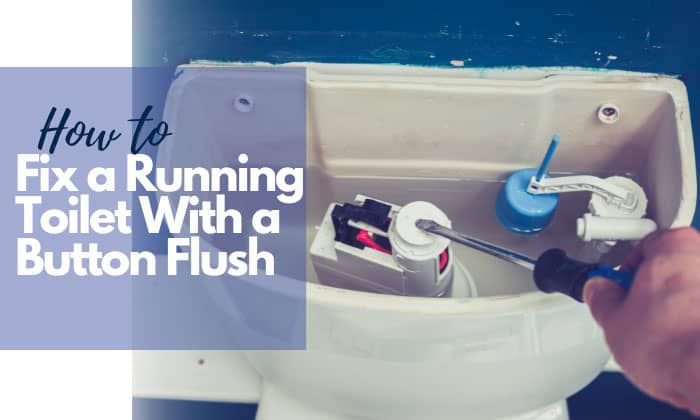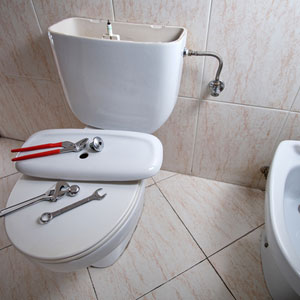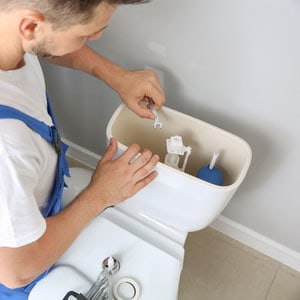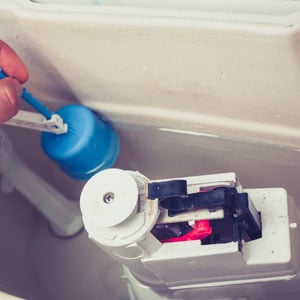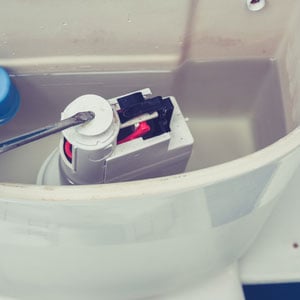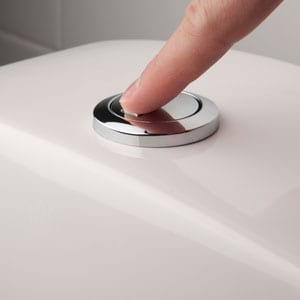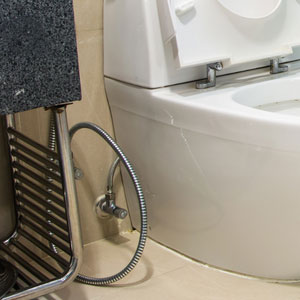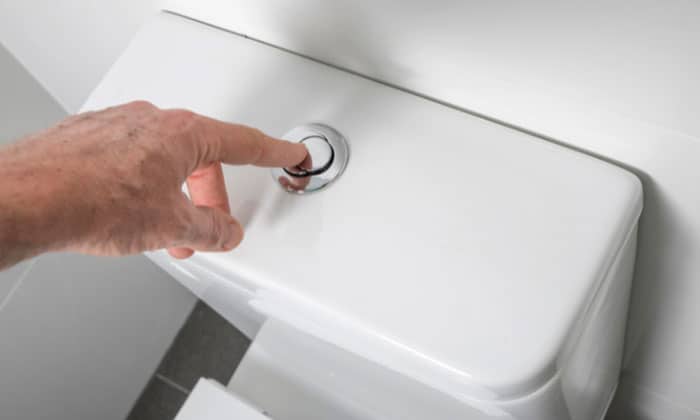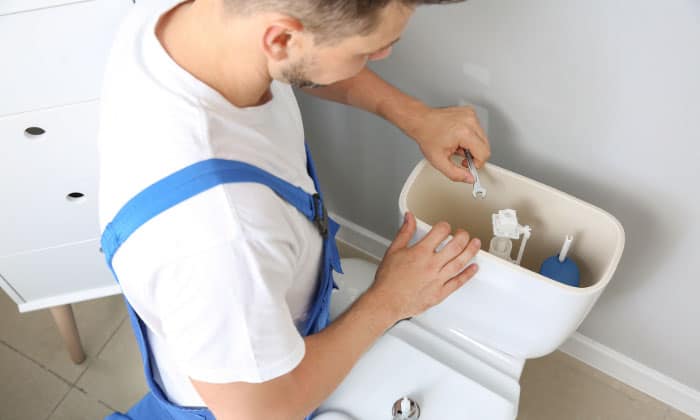Have you ever been in a situation when your toilet was running nonstop? It can be a frustrating and annoying experience, especially if you don’t know how to fix it. If you are running into this problem, you may be wondering how to fix a running toilet with a button flush.
Fortunately, it’s not as difficult as it may seem. A running toilet is typically caused by a faulty fill valve, flush valve, or loosely sealed toilet flapper, and you can have them replaced to improve your toilet’s efficiency. In this article, we’ll provide step-by-step instructions to fix a running toilet with a button flush.
Table of Contents
Step-by-Step to Fix a Running Toilet With a Button Flush
What to prepare
Before proceeding with a push-button toilet flush replacement, prepare items as follows:
- Gloves
- Screwdriver
- Wrench
- Rag, cloths
- Measuring tape
- New parts (fill valve, button flush, or flush valve)
Step 1: Remove the tank’s lid
The first step to fixing a toilet flush button is to get a good grasp of what we need to take care of by inspecting the inside of the toilet tank.
To remove the tank’s lid, unscrew the button flushes by pressing your fingers on the button and turning in an anti-clockwise direction. If you have a dual button flush that is fixed underneath, you just need a screwdriver to remove the button.
After this, you can take off the toilet lid and place it in a safe place.
Step 2: Inspect the issue
Now it’s time for you to find the root cause of your push button toilet flush problems.
Look into the tank and see if the level of water is too high compared to the overflow tube’s height. If so, the problem likely comes from the fill valve when there is too much water, and it’s overflowing through the tube, causing the toilet to run nonstop.
If you have checked and there is nothing wrong with the fill valve or the float, then it’s the toilet flapper that is at fault. The toilet flapper tends to lose its durability over time, and limescale might build-up, which makes it harder to seal the tank properly.
These are the reasons why the toilet cistern still running after flushing and filling the bowl with excessive water, making your monthly water bill go up.
Step 3: Replace the fill valve
To replace the fill valve, follow these steps as below:
- Disable the water flow by finding the valve on the wall near your toilet, and turning it in a clockwise direction. After that, flush a few times to empty the tank completely.
- Next, remove the water supply line by using a wrench to loosen up the coupling, then proceed to detach the fill valve nut underneath the toilet tank.
- After that, you need to separate the tank’s refill tube from the overflow tube before completely taking out the fill valve.
- To install a new fill valve, you should check for the durability of the gasket seal and make sure that it is not too loose. This is important, since if the gasket seal doesn’t work properly, leaks will flow down the bowl.
- Next, temporarily put the new fill valve in, using a measuring tape to make sure there’s a distance of 3 inches between the overflow tube’s top and the valve’s top cap.
- If the height needs to be adjusted, find the threaded shank on the valve’s body and turn it in either direction, depending on how higher and lower you want it to be.
- After you fix the valve’s position, secure the locknut firmly, and connect the water line.
- The last step to take is to attach the refill tube back to the overflow tube. You can cut the tube to let it fit the position, so there will be no water leaking into the bowl.
Step 4: Fix the flush valve/ flapper
When the problem does not lie in the fill valve but in the flush valve’s flapper being unable to seal properly, you also need to have it replaced.
- Take a look at the dual flush toilet mechanism. To take the dual flush valve out, turn it clockwise. However, in some cases, it may require turning counter-clockwise instead.
- Inspect the flapper to detect possible issues, such as being covered with dirt, limescale, or being hardened and worn out. If it looks to be in good condition, save for the dirt, you can just clean all the debris from the flapper. If not, replace it to avoid leaks from the tank.
- To improve the sealing effect, apply a thin layer of vaseline on the seal before installing it back.
- When done replacing or cleaning, put the flush valve back and position the flush button to fix on its position.
You might be wondering now whether you need to replace the button, and the answer will depend on which part of the toilet tank the issue lies.
If the button flush is broken, or push button toilet flush stuck down, and you can’t push it, then you must replace the button.
To fit the flush button, you need to unscrew the nut lying at the back of the button first. Then, adjust the push button toilet flush until it fits, and screw the but tight again.
Step 6: Connecting the water supply
Now, put the tank’s lid back on. By now, you can reconnect the water supply and turn on the water valve on the water. Wait for the tank to refill to see if the problem has stopped.
What Causes This Problem?
Your dual-flush toilet keeps running after flushing for one of three reasons: a worn-out valve seal, a malfunctioned fill valve with a higher-than-normal water level, or a broken flusher.
1. Worm-out valve seal
The toilet’s valve seal can become defective over time and fail to work properly. Debris or dirt could get in the way between the valve seal and the tank’s hole, so the seal is not completely closed, and leaks are constantly occurring.
2. Malfunctioned fill valve
On the left-hand side of the toilet tank lies the toilet fill valve, which has the function of filling the toilet tank after each flush.
When you start to flush, the toilet’s float inside the tank will control the amount of water flowing into the toilet bowl. It does so by moving from the tank’s bottom, where the fill valve opens, to the pre-set height, where the valve closes to shut off the water flow.
Excess water may flow down the overflow tube to the toilet bowl if the float is set too high (more than 12 inches above the tank’s overflow tube).
3. Broken flusher
If the issue lies directly in the broken flusher on the toilet, then you should consider replacing the push button. A broken flush button may result in a toilet that will not flush at all, or the button may become stuck, and water will continue to flow in the toilet bowl without stopping.
Helpful Tips/ FAQs
How do I fix the toilet’s tank water level?
The push button toilet flush mechanism diagram can be improved by fixing the water level.
To adjust the level of water inside the tank, you need to use a screwdriver or your bare hands to turn the plastic screw along the toilet float anti-clockwise. Make sure the water level is 12 inches below the overflow tube of the toilet.
How much does it cost in total to fix a toilet flush button which is broken?
There are several common types of push button toilet flush on the market, namely: dual flush buttons, single push buttons, or a level handle and a pull one. In any case, they would cost around $5 to $10.
A new fill valve, meanwhile, will cost at most $20, and the price of a flush valve ranges from $20 to $70.
Another option for you is to hire a professional plumber, and they will charge you from $60 to $150 to replace the parts.
Conclusion
A running toilet is not a difficult thing to fix, since it involves the replacement and cleaning of the inner mechanism inside the toilet tank. That said, remember to always use caution when working with plumbing and to contact a professional if you are unsure of how to fix a running toilet with a button flush.
Next time you push button toilet keeps running, follow our steps to fix a running toilet, and with the right knowledge and a few simple steps, you’ll be able to get your toilet running smoothly again in no time.

I’m Paulk Webb, and I work as a writer for Saveourwaterrebates. I’m happy to put in the time and effort to conduct market research to identify the most pressing issues faced by households concerning their plumbing. Feel free to check out our guides to get the most informed recommendations for how to solve your problems.


